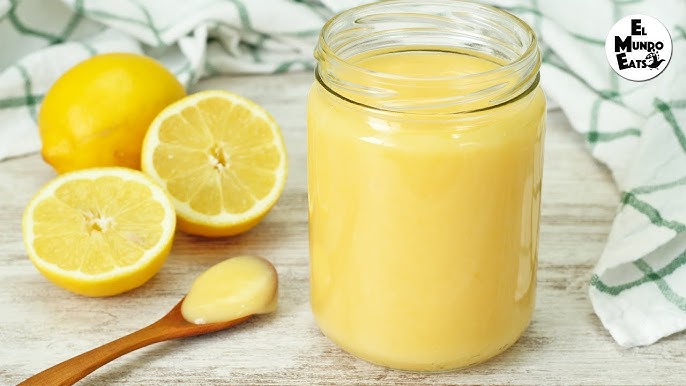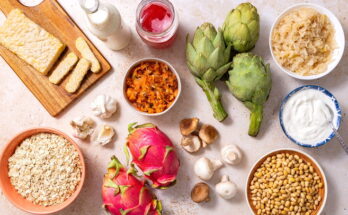Lemon Curd Recipe: Lemon curd is a luscious, tangy, and sweet custard-like spread made with fresh lemons, eggs, sugar, and butter. Popular in British cuisine, it’s a versatile ingredient that adds a zesty punch to desserts, breakfast dishes, and more. Think of it as a citrusy delight that can elevate anything from scones to yogurt.
Why Make Lemon Curd at Home?
While store-bought lemon curd might be convenient, nothing beats the flavor of homemade. It’s fresher, tastier, and allows you to control the sweetness and tanginess. Plus, it’s surprisingly easy to make, with just a few simple steps and ingredients.
Ingredients for Lemon Curd
Basic Ingredients List
- 4 large egg yolks
- 1 whole egg
- 1 cup granulated sugar
- ½ cup fresh lemon juice (approximately 3–4 lemons)
- 2 tablespoons lemon zest
- 6 tablespoons unsalted butter, cut into small cubes
Importance of Fresh Ingredients
For the best results, always use fresh lemons. Bottled lemon juice won’t deliver the vibrant flavor that makes lemon curd irresistible. Similarly, opt for high-quality butter for a creamy finish.
Substitution Tips for Ingredients
- Sugar: Adjust the amount for a sweeter or more tart curd.
- Butter: Use plant-based alternatives for a dairy-free version.
- Lemons: Experiment with other citrus fruits like oranges or limes for a unique twist.
Essential Kitchen Tools
Tools You’ll Need
- Medium-sized saucepan
- Whisk
- Fine-mesh strainer
- Heat-resistant mixing bowl
- Spatula
- Measuring cups and spoons
Choosing the Right Utensils for Best Results
A sturdy whisk ensures the curd stays smooth and lump-free. The fine-mesh strainer is crucial for removing any cooked egg bits, leaving a silky texture. Non-reactive cookware, like stainless steel, prevents a metallic taste from interfering with the flavor.
Step-by-Step Recipe Instructions
1. Preparing Your Ingredients
Before starting, gather and measure your ingredients. Zest and juice the lemons, separate the egg yolks, and cube the butter. Prepping everything in advance ensures a seamless cooking process.
2. Mixing the Ingredients
- In a heat-resistant mixing bowl, whisk together the egg yolks, whole egg, sugar, lemon juice, and zest.
- The mixture should be smooth and well-blended before you proceed.
3. Cooking the Mixture
- Transfer the mixture to a medium saucepan and place it over low to medium heat.
- Stir continuously with a whisk or spatula to prevent curdling.
- The mixture will gradually thicken, typically taking about 8–10 minutes. You’ll know it’s ready when it coats the back of a spoon and holds its shape when you run your finger through it.
4. Adding Butter
- Once the curd is thickened, remove it from the heat.
- Gradually whisk in the butter, one cube at a time, until it’s fully melted and incorporated. This step gives the curd its creamy texture and rich flavor.
5. Final Straining and Storing
- Strain the curd through a fine-mesh strainer into a clean bowl.
- Transfer the smooth curd into sterilized jars, leaving a little headspace. Allow it to cool before sealing and refrigerating.
Tips for Perfect Lemon Curd
Avoiding Common Mistakes
- Don’t Rush the Cooking Process: Cooking over high heat may curdle the eggs. Patience is key—stick to low or medium heat and stir constantly.
- Zest Carefully: Avoid the bitter white pith when zesting lemons. Use a fine grater or microplane for best results.
- Strain for Smoothness: Even if you think your curd looks perfect, straining ensures it’s free of lumps or zest bits.
Ensuring the Right Consistency
The right thickness of lemon curd depends on slow cooking and consistent stirring. If your curd feels runny, it likely needs more time on the stove. Cook until it coats the back of a spoon, a classic test for custards.
How to Adjust the Sweetness or Tanginess
- Prefer sweeter curd? Add an extra tablespoon of sugar during mixing.
- Craving more zing? Increase the amount of lemon zest or juice slightly. Taste as you go to find the perfect balance.
Creative Uses for Lemon Curd
1. As a Spread
Lemon curd is the ultimate toast topper! Spread it on fresh bread, muffins, scones, or bagels for a vibrant breakfast treat.
2. As a Filling for Desserts
Use it as a filling for cakes, cupcakes, or pastries. Lemon curd pairs beautifully with sponge cakes and serves as a bright layer in trifles or tarts.
3. Pairing with Savory Dishes
Yes, you can pair lemon curd with savory dishes! Its tangy sweetness complements roasted chicken or can act as a dip for cheese platters.
Storage and Shelf Life
Proper Storage Methods
Store your lemon curd in sterilized, airtight jars to maintain freshness. Keep them in the refrigerator and ensure the curd is fully cooled before sealing the jars.
How Long Does Lemon Curd Last?
Homemade lemon curd typically lasts up to 2 weeks in the fridge. For longer storage, you can freeze it. Simply transfer to freezer-safe containers and use within 3 months.
Troubleshooting Lemon Curd
Why Did My Lemon Curd Curdle?
Curdling occurs when the eggs are cooked too quickly or at too high a heat. If you notice curdling, immediately remove the pan from heat and whisk vigorously. Straining can help salvage the texture.
How to Fix Runny Lemon Curd?
Runny lemon curd usually means it wasn’t cooked long enough. Return the mixture to low heat and continue stirring until it thickens. If it’s still too thin after cooling, you may need to remake it with additional cooking time.
FAQs about Lemon Curd Recipe
What is lemon curd?
Lemon curd is a rich, tangy spread made from fresh lemons, sugar, butter, and eggs. It’s often used as a topping for desserts, a filling for pastries, or a spread for toast and scones.
How long does lemon curd last?
When stored in an airtight container in the refrigerator, homemade lemon curd typically lasts for up to two weeks. Ensure it stays chilled for freshness.
Can I freeze lemon curd?
Yes, lemon curd can be frozen for up to three months. Store it in a freezer-safe container and allow it to thaw in the refrigerator before use.
Why did my lemon curd curdle?
Curdling usually occurs if the heat is too high or the eggs cook too quickly. To prevent this, cook the mixture on low heat and stir constantly.
What can I use lemon curd for?
Lemon curd is versatile and can be used as a filling for cakes, tarts, and crepes or as a topping for pancakes, yogurt, or ice cream. It’s also delicious on its own!
Conclusion
Making lemon curd at home is a rewarding process that gives you a fresh, tangy, and versatile treat to enjoy. Whether you’re spreading it on toast, using it as a dessert filling, or experimenting with creative pairings, lemon curd is a must-have recipe in any home cook’s repertoire. By following this step-by-step guide and incorporating the tips provided, you’ll achieve a perfect batch every time. So, grab those lemons and get started!



